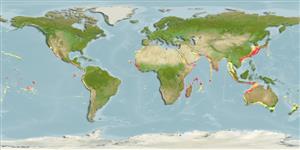Environment: milieu / climate zone / depth range / distribution range
Ecologie
marien rifbewoner; diepte 50 - 300 m (Ref. 28016). Subtropical; 35°N - 50°S, 32°E - 5°W
Southeast Atlantic: St. Helena and Ascension islands (Ref. 7097). Western Indian Ocean: southern Red Sea, off Oman and Sri Lanka. Eastern Pacific: Hawaiian and Revillagigedo islands (Ref. 9283). Reported from the Arafura Sea (Ref. 9819) and Persian Gulf (Ref. 68964).
Grootte / Gewicht / Leeftijd
Maturity: Lm ? range ? - ? cm
Max length : 58.0 cm TL mannelijk / geslacht onbekend; (Ref. 55763); common length : 35.0 cm TL mannelijk / geslacht onbekend; (Ref. 55763)
Dorsale stekels (totaal): 9; Dorsale zachte stralen (totaal): 25-30; Anale stekels 3; Anale zachte stralen: 19 - 22.
Adults are benthopelagic in sandy bottoms at the foot of the edge of the outer reefs, continental coasts and around islands (Ref. 9283). Solitary or forming small schools (Ref. 30573). Mainly nocturnal (Ref. 4887). Marketed fresh and salted or dried (Ref. 9283).
Levenscyclus en paargedrag
Maturiteit | Voortplanting | Paaien | Eieren | Fecunditeit | Larven
Smith-Vaniz, W.F., 1984. Carangidae. In W. Fischer and G. Bianchi (eds.) FAO species identification sheets for fishery purposes. Western Indian Ocean fishing area 51. Vol. 1. [pag. var.]. FAO, Rome. (Ref. 3287)
Status op de Rode Lijst van het IUCN (Ref. 130435)
Gevaar voor de mens
Harmless
Gebruik door de mens
Visserij: van minder commercieel belang; sportvis: ja
Meer informatie
Lokale namenSynoniemenMetabolismePredatorenEcotoxicologieVoortplantingMaturiteitPaaienPaaiaggregatiesFecunditeitEierenOntwikkeling van de eieren
ReferentiesAquacultuurAquacultuurprofielKweeklijnenGeneticaElectrophoresesErfelijkheidZiektesVerwerkingNutrientsMassaconversie
Tools
Speciale rapporten
Download XML
Internetbronnen
Estimates based on models
Preferred temperature (Ref.
123201): 14.5 - 26.8, mean 20.2 °C (based on 410 cells).
Fylogenetische diversiteitsindex (Ref.
82804): PD
50 = 0.6250 [Uniqueness, from 0.5 = low to 2.0 = high].
Bayesian length-weight: a=0.01445 (0.00841 - 0.02484), b=2.94 (2.80 - 3.08), in cm total length, based on LWR estimates for this species & (Sub)family-body (Ref.
93245).
Trofisch niveau (Ref.
69278): 3.8 ±0.58 se; based on food items.
Weerstandsvermogen (Ref.
120179): Gemiddeld, minimale populatieverdubbelingstijd 1,4-4,4 jaar (Preliminary K or Fecundity.).
Fishing Vulnerability (Ref.
59153): Moderate vulnerability (43 of 100).
Nutrients (Ref.
124155): Calcium = 30.3 [14.2, 54.0] mg/100g; Iron = 0.813 [0.459, 1.464] mg/100g; Protein = 20.2 [19.2, 21.2] %; Omega3 = 0.257 [0.163, 0.421] g/100g; Selenium = 23.1 [12.1, 42.8] μg/100g; VitaminA = 48.7 [18.3, 128.0] μg/100g; Zinc = 0.579 [0.394, 0.848] mg/100g (wet weight);
